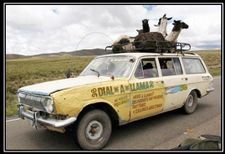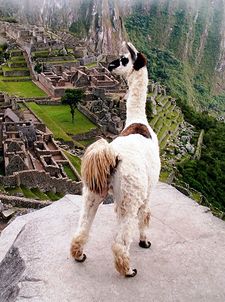User:Knucmo2/Llama agility
“I'm not obsessed with llamas. Anyone who thinks I am will become a hate-figure in my next line of Sim Games. So there!”
– Will Wright, Maxis Boss, on something he's not definitely not obsessed with
“I am obsessed with llamas! Or riding them at least! And I'm happy to say that - Peace out”
“An agile llama can yield the owner many things. But a life is not one of them”
“We have a keen appreciation of the need for our species to lead an active, healthy life, in line with the constitution of our adopted land, wherever that may be.”
– Barack O'Llama, elder and wiseman of the Llama species
The aforementioned Neil Young in one of his more sober moments once said: 'I'm going to ride my llama, from Peru to Texarkana'. This is quite some feat. Obviously, Neil could call upon a very well-trained llama to take him all the way. Llama agility, in spite of what you might presume, is a subject which has attracted viewpoints from the finest minds from East and West from profound philosophy to extreme nihilism. It was also important in the development of certain seminal theories in mathematics as well as politics. This article will aim to present a basic overview of the development of thought on the subject of llama agility, and will also offer some homely tips as to how your llama could well improve its finesse.
1. Ancient Practicalities[edit | edit source]
Llamas, like stylish football, sultrous sambas and plentiful cocaine came to be in South America, after migration from the colder North. They were seen by hominids bordering on the prehistoric as a kind of overgrown sheep, and their innate agile qualities were not really exploited.
Some time later though, ancient civilisations had some good ideas about llamas even before a certain namby-pamby pacifist came along and told us the Word on Everything. Firstly, they came to see them as species in their own right which is somewhat of a necessary start (but not sufficient, as academic philosophers might say). Secondly, they used llamas as carriers of their goods from place to place. The llamas grew used to carrying heavy goods at high altitudes. They were purely practical creatures for these humble shepherding folk. It was not until much later that their feats of agility became the subject of poncy theorizing by bearded fellows.
2. Beginnings of Thought[edit | edit source]
The llama began to gain considerable interest from thinkers of the day. Socrates said: 'Would that my mind was as nimble and agile as the walk of the South American llama, I would have actually done something with my life and not stood around annoying people'.
The first person to codify thought on how to bring out the agility inherent in your llama is unknown, but some historical documents give evidence that a school of thought was growing around llama agility. The documents are dated from 400 A.D. Amongst its salient points are:
- Llamas do not like drama. Demonstrate everything to them slowly.
- Do not leave your llama untended. Remember, even an untrained llama has enough agility to run off and leave you for dead.
- A frog-only diet is essential during competitions. It is thought ingestion of frog increases the llama's general jumpiness.
- Do not try demonstrating star-jumps to the llama. It has been observed in a number of cases that this annoys the llama to a point of murderous rage which has resulted in the deaths of some owners.
Around this time, llama racing developed as a sport in the South American region. The Peru-Tekarkana race was a yearly occurrence though it was some hundreds of years before any llamas were able to make it past the Peruvian border, leaving the Tekarkana waiting party frequently frustrated. Of course, we must now turn our attention to the more profounder musings on camelid agility.
3. The Early Modern Era[edit | edit source]
But first, a brief survey of the uses of this creatures' innate ability. It was said during the Incan era that as well as great llama races taking place, llamas would be used by their trainers to perform feats not too distant from the skateboarders of present era. For instance, the Incans would regularly take their llamas to high plains (as seen in the photograph nearby) and would instruct them to jump off and see if they could land on their feet.
More often than not, this cruel practice resulted in the death of the poor llamas, but then they were in plentiful supply. There were some that did manage to perform this daredevil task successfully, and they were usually rewarded...by being forced to do it again.
This was a rather cynical use of the llama's agility, and indeed, it must be said that they did not simply drop off the platform, but would jump at quite a distance before inevitably plummeting. But the Incans 'advanced' on this cynicism. Faced as they were with invasion by the Spaniards in the 1500's, who had acquired a taste for Empire as strong as a Cuban's for fine cigars, they started using llamas as weapons against the Spaniards. Llamas would be strapped with a lethal mixture of potassium nitrate and sulphur and would be urged to race towards the Spanish at full speed, which for a fully trained llama could be up to 35 kilometers per hour! Needless to say, this practice was inimical to the Incans, as the llamas deeply honed instinct would impel it to return to its owner in such warlike chaos as a battle, and thus, the llama exploded more Incans than Spaniards.
One of Pizzaro's acts was to ban the exploitation of llamas for amusing or exploitative purposes. Sadly, this also banned any human training of llamas whatsoever, even for purposes beneficial to the llama. As a result of this, many llamas became obese and they began to lose their agility through years of lassitude and sedentary lifestyle.
4. Philosophical Ideas[edit | edit source]
Of course, I neglect to mention the very philosophical ideas concering llama agility that I have promised to discuss. But what of the llama and his prized agility? We must not neglect that. Llamas were to put to use again when the conquerors of South America discovered ore was to be mined from the mountains. Llamas, with their strength and ability in this regard, were used to bring down the ponderous deposits. However, they soon found themselves out of jobs when donkeys, mules and horses became more popular as beasts of burden (and to add another minor second to this dissonant chord of tragedy, they were more adroit than the llama). It was something no amount of unionizing could have prevented. However by the early 19th century, llamas had now begun to be imported by a newly emerging nation, which itself would come to be led by donkeys and elephants one day. They enjoyed life as pets under their new owners, and it is said that they enjoyed a good quality of life, as they were looked upon with higher regard than the Negro slaves, especially in the Confederate South.
5. And finally, those great thinkers and llamas[edit | edit source]
And so, this brings us nicely on to our great thinkers and their views on the agility of the llama, and how the subject in turn influenced their own theories. Naturally, if you think I am to continue in this exposition, you must be the world's most callow, dupable git. Honestly, what on earth led you to believe that the great thinkers had anything profound to say on the subject?
Did you bother to verify that Socrates' quote I carelessly tossed in before? I bet you didn't. The photograph immediately to the right just served to satisfy the infinitesimally small faculty of your brain that deals with critical thinking.
What's worse is I could have gone on with the deception and actually made up some guff about Kant or some other philosopher being inspired by llamas when they wrote their masterpieces. Or that mathematicians used llamas as some sort of calculating device. And if I had, you would have gobbled up every last syllable, phoneme and diphthong of it as much as a lonely, depressed male teenager devours hardcore pornography. God knows what you would have done armed with that information, apart from make yourself a more asinine fool than I had given you, <insert name here>, credit for!
You make me sick. You're worse than a llama. Even a very fat, slovenly one at that.
Also, I can't actually give you any tips on llama agility. I don't have the foggiest about them. Maybe ask Will Wright, who's married to one.



